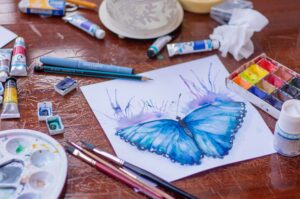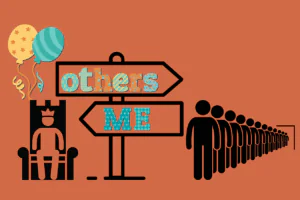Guest post by Erika Berg, MAT, LCPC
Have you heard the term “Art Therapy” and wondered what that is? Two words that seem unrelated on the surface have the capacity to be much more, as you will see when we dive a little bit deeper into the topic of “What is Art Therapy.”
Art therapy is relatively new in the field of counseling and psychology. It started in Great Britain and the United States in the mid-1900s. The American Art Therapy Association (AATA) was created in 1964.
According to AATA, “Art therapy is an integrative mental health and human services profession that enriches the lives of individuals, families, and communities through active art-making, creative process, applied psychological theory, and human experience within a psychotherapeutic relationship. Art therapy, facilitated by a professional art therapist, effectively supports personal and relational treatment goals as well as community concerns. Art therapy is used to improve cognitive and sensorimotor functions, foster self-esteem and self-awareness, cultivate emotional resilience, promote insight, enhance social skills, reduce and resolve conflicts and distress, and advance societal and ecological change.”
Requirements for becoming an Art Therapist:
Because it diverges from traditional talk therapy, the training to become an Art Therapist also differs. Art Therapists are Masters level clinicians who work with clients across the entire lifespan. Art Therapists follow ethical standards and practice within their scope of expertise, training, and education.
Their training requires knowledge of and skills in making visual art, such as drawing, painting, sculpture, and other varying art forms, as well as the creative process. They also complete training in various theories and techniques of psychology, counseling, and human growth.
Art Therapists work with individuals, families, couples, and groups who are navigating medical and mental health issues, as well as emotional, creative, and spiritual concerns. They can work in a variety of settings, such as hospitals, schools, residential treatment facilities, private practice, etc.
Licensure
There are various levels of credentialing within the art therapy field:
ATR credentialing stands for Registered Art Therapist
Because Art Therapists didn’t want to be designated as a “RAT”, the ATR credential is used instead. ATR is the credential that ensures an Art Therapist meets established standards, most importantly, successful completion of advanced specific graduate-level education in art therapy and supervised postgraduate art therapy experience.
ATR-P (Provisional Registered Art Therapist)
ATR-P is the credential that ensures an Art Therapist meets established educational standards. This includes successful  completion of advanced specific graduate-level education in Art Therapy, in addition to Art Therapy practice under an approved supervisor(s). Individuals are eligible to apply for this credential once they have completed their degree or education requirements for the ATR-Provisional and are engaged in a supervisory relationship with a qualified supervisor(s).
completion of advanced specific graduate-level education in Art Therapy, in addition to Art Therapy practice under an approved supervisor(s). Individuals are eligible to apply for this credential once they have completed their degree or education requirements for the ATR-Provisional and are engaged in a supervisory relationship with a qualified supervisor(s).
ATR-BC (Board-Certified & Registered Art Therapist)
ATR-BC is the highest-level Art Therapy credential. Individuals must pass a national examination, demonstrating comprehensive knowledge of the theories and clinical skills used in Art Therapy. All Board-Certified Art Therapists are required to recertify every five years through the completion of 100 continuing education credits or passage of the ATCBE national examination.
ATCS (Art Therapy Credentialed Supervisor)
ATR-BCs who have acquired specific training and skills in clinical supervision are designated as ATCS. Working with an ATCS ensures that current Art Therapy students and early-career practitioners receive the best supervision available.
Art Therapy vs Art Class:
Many people confuse Art Therapy to mean an art class, but they are not the same. In art class there is a focus on technique, and there may be a certain way to do something. It involves a student-teacher relationship and usually takes place in a studio or classroom. Interestingly, many of my clients have mentioned negative experiences with art class and will speak to that when engaging in Art Therapy. You won’t be graded in Art Therapy. It is a space free of judgment and critique. Instead, it focuses on your expression, the creative process, the therapeutic relationship, and confidentiality. The emphasis is not on developing a skill, but rather on using art as a way to facilitate your psychotherapeutic process.
There are non-art therapists who state that they use Art Therapy as a treatment modality. So do your research and use discernment when selecting a clinician who meets your specific needs. Some clinicians have taken certification programs and have the necessary training to facilitate Art Therapy, but some have not. There is a difference between Art Psychotherapy and art in therapy. Art Therapists use both paradigms in their work. They train to have an in-depth understanding of various media and how they can impact the art-making process and the client. Non-art therapists typically do not have this extensive training. If they are not practicing within their scope of expertise, there is the possibility of doing harm.
How does Art Therapy work?
All memories and emotions are stored and experienced visually and often include a physical or sensory component, rather than verbal. Since memories and emotions are not experienced verbally, and often lack the linear process of language, Art Therapy allows for a more natural way to communicate by focusing on the art-making process as well as the project created. It provides a sensory experience, emotional connection, and tangible product. Selective media choice provides boundaries and externalization that you may need as a client.
When you engage in creative expression, it arouses the parasympathetic branch of the autonomic nervous system. Breathing slows, blood pressure lowers, and the body gradually relaxes. This helps reduce the hyperarousal or flight/fight response associated with stress. Therefore, creative expression can modify our biochemistry and improve physical well-being. When you participate in art-making, your body can actually change.
What are the benefits of engaging in Art Therapy?
Art Therapy has a multitude of benefits, many of which have been documented in a variety of studies. Research continues to document it’s effectiveness. One study showed that 45 minutes of art-making can reduce cortisol levels. Other studies show that art-making activates specific areas in the brain that release endorphins and other neurotransmitters that relieve pain and trigger the immune system to function more efficiently. Endorphins are like opiates and create an experience of expansion, connection, and relaxation. In conjunction with these physiologic changes, art can change people’s attitudes, emotional states, and perceptions of pain.
In addition, it can assist in healing and navigating difficult life experiences. When you have experienced trauma, the movement of drawing/coloring/painting helps to reconnect your brain’s emotional retrieval structures with the structures that are responsible for linear sequencing, logic, and language. This reduces hyper-vigilance and flashbacks.
Anxiety can also be managed by Art Therapy. As the client, you can select from various media choices and directives. This can have a calming effect and encourage mindfulness. In addition, it can allow for the externalization of fears. This can be invaluable when verbal expression is difficult because art materials can be less threatening than verbal expression. So this type of therapy is a great fit for depression, trauma, and other disorders where talking can be taxing .
Engaging in Art Therapy can build frustration tolerance by providing methods to explore emotions that provide limits and safety. Additionally, it can be valuable when exploring self-esteem. It promotes skill building, and as the creator, you can take pride in the process and/or finished product.
Related Reading: How to Find a Therapist
Art Therapy assists with increased expression and self-regulation across a variety of populations. It fosters community building, a sense of belonging, acceptance, and togetherness. You can find an Art Therapist near you via the American Art Therapy Association. If you feel that you or a loved one could benefit from Art Therapy or other methods of treatment, the therapists at Life Care Wellness are here to help you. Please reach out to us in our Glen Ellyn, Chicago (Jefferson Park), Sycamore, or Yorkville locations.
Erika adapts her therapeutic approach through the lens of a client-centered and strengths-based perspective. In addition to Art Therapy, she uses Somatic Experiencing and EMDR in her work. Erika has experience working with mood disorders, substance abuse disorders, and trauma. She sees clients in the Glen Ellyn office and by telehealth.






